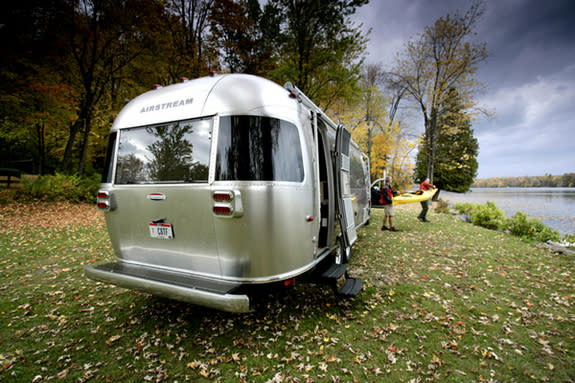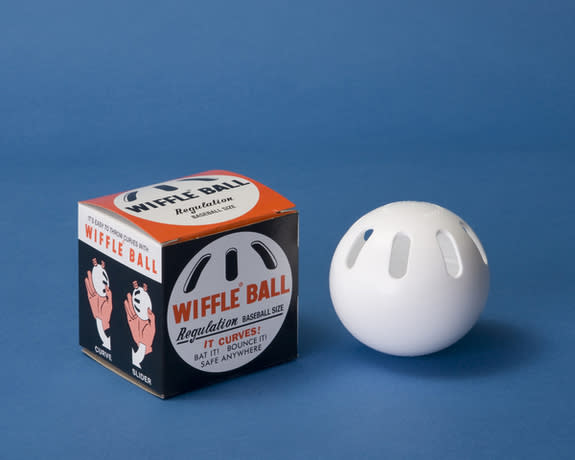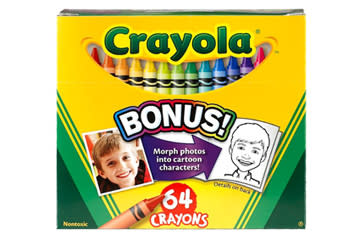13 Iconic Brands Still Made in America
"Made in America" is making a comeback. Every time you turn around, someone is talking about the need to bring manufacturing back to the United States and, with it, manufacturing jobs. Designers are increasingly finding ways to produce goods in the U.S. again, and American consumers are starting again to look for a "Made in America" label.
Some brands, however, never left America's shores. Here are 12 iconic American brands that are still made in the good old U.S.A.
Headquarters: Springfield, Mass.
"You've got to ask yourself one question: Do I feel lucky? Well, do you, punk?"
With those words uttered by Clint Eastwood as he held a .44 Magnum revolver in "Dirty Harry," a legendary American company became an icon. Started in 1852 by Horace Smith and Daniel B. Wesson, Smith & Wesson grew out of the factories of Springfield, Mass. into the largest manufacturer of handguns in the United States. Their products have become the most commonly used weapons among law enforcement personnel.
Today the company still produces its firearms in Springfield, but it also has facilities in Maine and Tennessee. Smith & Wesson also has expanded into the manufacture of handcuffs, knives, tools and tactical law enforcement footwear.
Headquarters: Hershey, Pa.
Around the turn of the 20th century, Milton Snavely Hershey began experimenting with candy manufacturing. After two unsuccessful business ventures, he found success with the Lancaster Caramel Co., but Hershey’s true interest was chocolate, so he sold his caramel company in 1900 for $1 million. He manufactured the first Hershey's chocolate bar soon afterward.
Today the company manufacturers candy in locations in Pennsylvania, Virginia and Illinois. The main facility and headquarters remains, however, in the section of Derry, Pa., that has long been called Hershey, the self-described "Sweetest Place on Earth." There visitors can enjoy an amusement park and tour of the Hershey's factory. Hershey is currently the leading manufacturer of chocolate and candies in North America.
Headquarters: Shelton, Conn.
It may not be considered the national pastime, but since the early 1950s Wiffle Ball has been an American staple. Started in 1953 by David N. Mullany, Wiffle Ball Inc. has changed very little since it released its original products, which were Mullany's way of safeguarding his son's pitching arm from injury. In fact, the Wiffle Ball bat and ball still have the same dimensions as when they were first sold, and there's the same artwork on the box.
Today the company still manufacturers its products in Shelton, Conn. It remains a family-run company with just 12 full-time employees that has sold its products to people in every state and 26 countries around the world.
Headquarters: Ada, Ohio
The 5,847 people of Ada, Ohio, might fill just one section of a professional football stadium, but the impact of this small town on the sport of football cannot be overstated. Since 1955 Wilson has made every football used in professional competition, including Super Bowls, at its Ada factory. Wilson says on its websitethat it opened the factory "to ensure that Wilson footballs would not only be American-made, but the highest-quality footballs ever produced."
Today the small town, located 80 miles from Columbus, Ohio, produces 4,000 footballs a day and 700,000 a year. It remains the only dedicated football factory in the world, employing 120 full-time employees averaging 23 years of work experience.
Headquarters: Louisville, Ky.
The first game of baseball is recorded to have occurred in 1846 in the town of Hoboken, N.J. Around that same time in Louisville, Ky., a German immigrant, J. Frederick Hillerich, opened a woodworking shop. It was not until 1880 that the two worlds intersected, when Hillerich's son, John Andrew "Bud" Hillerich, began making baseball bats for his amateur team. Several years later the Lousiville Slugger Co. began producing bats for professional baseball player Bud Browning, and word of the bats from Louisville soon spread. Soon the factory was producing bats for Honus Wagner, Babe Ruth, Ty Cobb and Lou Gehrig.
Today Louisville Slugger employs 155 people at its 100,000-square-foot factory in Louisville. The company has survived fires and floods to remain one of the most popular suppliers of bats. Of the 1 million bats it produces a year, 60,000 go to professional ballplayers. More than 125 years after its opening, the Louisville Slugger Co. remains family-owned, with Bud Hillerich's grandson, John A. Hillerich IV, serving as president and CEO.
[5 Things You Don’t Know About Burbon]
Headquarters: Hollidaysburg, Pa.
For Richard James, all it took was $500 and a chance occurrence to launch one of the most successful toys in history. James, a naval engineer, was conducting an experiment with tension springs when one fell to the floor and began to move oddly. James thought that with the right amount of tension, the spring could "walk." After bringing the idea home, he and his wife, Betty, came up with the name Slinky for the toy and launched it at Gimbel’s Department Store in Philadelphia in 1945. They were unsure of how the toy would sell, but the first 400 sold out within 90 minutes, and the rest is history.
More than 300 million Slinky toys have been sold since the toy spring's introduction in 1945. In 1966 Slinky moved its production to Hollidaysburg, Pa., and since then every Slinky has been made at that facility. The Slinky has become an iconic American toy, and the jingle used to sell it is one of the longest-running in advertising history. In 2001, the Slinky was named the official toy of Pennsylvania.
Headquarters: Nashville, Tenn.
Before anyone could have conceived of rock and roll, luthier Orville Gibson was starting the company that would produce the genre's signature item, the electric guitar. (Luthiers make lutes or other stringed instruments.) Gibson started the Gibson Guitar Co. in 1896 in the town of Kalamazoo, Mich. It released its first electric guitar in 1936.
After the original Kalamazoo plant closed in 1984, the world headquarters of Gibson was moved fittingly to "Music City": Nashville, Tenn. Gibson makes 2,500 guitars a week at its Gibson USA plant there. The plant employs 500 workers who help to hand-craft each guitar. From its humble beginnings Gibson has grown to be an icon in the music industry, with artists like Eric Clapton and Paul McCartney using its products.
Headquarters: Easton, Pa.
When Edwin Binney and C. Harold Smith won a gold medal at the 1900 World's Fair for a dustless chalk product, they were simply responding to the needs of local teachers. It was not until three years later that they would create their iconic product: a set of safe and affordable wax crayons. The first pack of Crayola crayons had eight colors. Since then, many colors have been added to the lineup and the company has expanded into other products, including markers and colored pencils.
Crayola has not moved far from its original production center in Pennsylvania. Since 1969 Crayola has manufactured its popular crayons at its Easton and Bethlehem, Pa., factories. The company also has manufacturing facilities in Mexico City and Brazil handling its overseas operations. It is, however, the Easton, Pa., factory that has produced over 1 billion crayons since opening in 1969.
Headquarters: Shelbyville, Tenn.
The first Sharpie markers came out in 1964, but the story behind their production goes back over 100 years before that. In 1857 Frederick W. Redington and William H. Sanford founded the Sanford Manufacturing Co. in Worcester, Mass. The company focused on selling and producing glue and ink until the 1960s, when it noticed an opportunity in the emerging marker industry.
Today Sharpie markers are made in Shelbyville, Tenn., by the Newell Rubbermaid Co. The Sharpie marker has become one of the best-selling writing instruments in history, with over 200 million Sharpie markers sold as of the year 2002.
Headquarters: Milwaukee, Wis.
For the past century, the Harley-Davidson name has been linked with motorcycles. Started in 1903 by two sets of brothers, the Harley-Davidson company grew out of a wooden shed in Milwaukee, where childhood friends Arthur Davidson and William S. Harley began to experiment with a combustion engine that would fit into a bicycle. The company sold its first motorcycle in 1903.
Today Harley-Davidson headquarters is still in Milwaukee. The company has two other Wisconsin factories, in Tomahawk and Menomonee Falls, plus factories in York, Pa., and Kansas City, Mo. Although many parts are made in other countries, all Harley-Davidson bikes are assembled in the U.S. plants.
Headquarters: Greenville, Ohio
It was described as being the perfect “kitchen aid” by an executive's wife, and the name for the stand mixer stuck. Since then the Kitchenaid brand has grown into a leader in the appliance industry, but it all started with that mixer launched in 1919 as an alternative to large mixers in restaurants. In the following decades, Kitchenaid expanded into popular products such as dishwashers, refrigerators and blenders.
All Kitchenaid mixers are still made in Greenville, Ohio. The factory employs hundreds of people and can process up to 7,000 units a day.
[7 Things You Didn't Know About Pencils]
Headquarters: Jackson Center, Ohio
It was on a camping trip that Wally Byam got the idea to start the Airstream Trailer Co. Byam had bought an old Model T chassis and built a tent on it, but it was an uncomfortable and time-consuming process. Byam then thought of building a tear-shaped aluminum shelter with an ice box and small stove in it, and the first Airstream was soon created in Byam’s Los Angeles backyard. Soon after this idea in 1932, the Airstream Trailer Co. began producing its early trailers.
Airstream has been producing its trailers in Jackson Center, Ohio, since 1952. The company still operates under the mantra of Byam: "Let's not make any changes ? let's make only improvements." The company manufacturers about 1,000 motor homes a year.
Headquarters: Bradford, Pa.
There are a lot of numbers that can tell the story of Zippo's success. For starters you could look at the 60,000 lighters the company produces every day in its Bradford, Pa., factory, or the 12 million lighters it sells every year, but perhaps the number most indicative of its success is 500 million. That’s because on June 5, 2012, the company produced its 500 millionth iconic lighter on what would have been the 117th birthday of the company's founder, George Blaisdell. In the more than 80 years since starting, Zippo has become one of the most recognizable brands in the world, with its lighters being sold in more than 160 countries. They also have appeared in more than 1,500 movies, the company says.
Today George Duke, Blaisdell's grandson, owns Zippo along with the Case Cutlery Co., acquired in 1994, and the Ronson brand of lighters and fuel, acquired in 2010. The company employs almost 800 people in its Pennsylvania factories.
This story was provided by BusinessNewsDaily, a sister site to LiveScience. Follow BusinessNewsDaily on Twitter @BNDarticles. We're also on Facebook & Google+.
Copyright 2012 LiveScience, a TechMediaNetwork company. All rights reserved. This material may not be published, broadcast, rewritten or redistributed.




